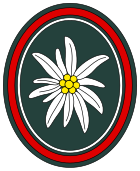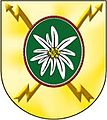Mountain Infantry Brigade 23
|
Mountain Infantry Brigade 23 |
|
|---|---|
 Association badge |
|
| Lineup | May 1957 |
| Country |
|
| Armed forces | armed forces |
| Armed forces |
|
| Branch of service | Mountain troop |
| Subordinate troops |
|
| Strength | 5,300 men |
| Insinuation | 10th Armored Division |
| Seat of the staff | Bad Reichenhall |
| march | King Ludwig II march |
| Web presence | GebJgBrig 23 |
| commander | |
| commander | Colonel Maik Keller |
The Gebirgsjäger brigade 23 "Bayern" ( GebJgBrig 23 ), fully deployed in the southern Bavaria , the core forming Gebirgstruppe of the army of the German Federal Armed Forces . The headquarters of the brigade staff is in the Hochstaufen barracks in Bad Reichenhall . The brigade with a strength of 5,300 soldiers is subordinate to the 10th Panzer Division .
assignment
The brigade carries out operations in a multinational framework in the entire intensity spectrum and is particularly qualified for use in the most difficult terrain and under extreme climatic and weather conditions. As a valuable training tool, the mountains are the basis and prerequisite for achieving and maintaining this special skill. In addition to the use in mountains, high mountains and in arctic terrain, the use in the desert is a focus.
badge
The soldiers wear the edelweiss as a sleeve and cap badge as a traditional symbol of the mountain troops, which from 1907 only served the kk mountain troops of the Austro-Hungarian army as a branch of arms badge , but in October 1915 by the commanding general of the Austrian Southwest Front, Archduke Eugen , in the hotel Elefant in Brixen was also awarded to the German Alpine Corps as a badge in recognition of his performance in defending against the Italian offensives in the Austro-Hungarian Alpine region. A Gothic coat of arms, as it is carried by the other brigades of the army, is unknown to the Gebirgsjägerbrigade 23, but the internal association badge of the headquarters company shows a three-part coat of arms shield with the Bavarian colors white and blue, the panther , heraldic animal of the city of Bad Reichenhall and the edelweiss on green Reason, the weapon color of the infantry . As with all other brigades in the army, the red border around the coat of arms indicates that it is the second brigade of the former 1st Mountain Division .
structure
-
 Headquarters / Telecommunication Company Gebirgsjägerbrigade 23, Bad Reichenhall
Headquarters / Telecommunication Company Gebirgsjägerbrigade 23, Bad Reichenhall
-
 Mountain Infantry Battalion 231, Bad Reichenhall
Mountain Infantry Battalion 231, Bad Reichenhall -
 Mountain Hunter Battalion 232, Bischofswiesen - Strub
Mountain Hunter Battalion 232, Bischofswiesen - Strub
-
 Mountain Infantry Battalion 233 , Mittenwald
Mountain Infantry Battalion 233 , Mittenwald
-
 Mountain Reconnaissance Battalion 230, Füssen ( Allgäu barracks )
Mountain Reconnaissance Battalion 230, Füssen ( Allgäu barracks ) -
 Mountain Pioneer Battalion 8, Ingolstadt
Mountain Pioneer Battalion 8, Ingolstadt
-
 Mountain Supply Battalion 8, Füssen (parts in Mittenwald and Bad Reichenhall )
Mountain Supply Battalion 8, Füssen (parts in Mittenwald and Bad Reichenhall ) -
 Operation and training center for pack animals 230 , Bad Reichenhall
Operation and training center for pack animals 230 , Bad Reichenhall
Each of the mountain hunter battalions is divided into three mountain hunter companies 2nd / - 4th /, a 5th / heavy mountain hunter company and a 1st / staff and supply company.
history
The brigade traces its line of tradition back to the mountain rifle corps founded in 1805 as the predecessor of the Bavarian mountain troops. Traditionally, the units wear the edelweiss badge awarded to the German Alpine Corps in 1915.
In 1957 ( Army Structure I ), Combat Group A8 was set up as the predecessor of the brigade. The first mules were used in a pack animal train as early as 1960 (predecessor of the later mountain carrier company 230).
During the Cold War , the 23 Mountain Infantry Brigade was one of the two mountain brigades of the 1st Mountain Division at the time , the third brigade of which was the 24th Panzer Brigade . The 1st Mountain Division was subordinate to the II Corps (GE). In 1973 the brigade was reclassified and the Mountain Supply Battalion 236 disbanded. The Mountain Medical Company 230, Mountain Supply Company 230, Mountain Repair Company 230, Mountain Carrying Animal Company 230 were formed from his companies .
In Army Structure IV , the Brigade in 1981, in addition to the previous Gebirgsjäger Battalions 231 and 232, were subordinated to the Gebirgsjäger Battalions 233 and 234 (previously 221 and 222 of the former Gebirgsjäger Brigade 22) from Mittenwald and the Gebirgspanzerjägerkompanie 230 with 17 battle tanks from Landsberg / Lech and the mountain company the mountain supply company 230 dissolved. The latter and the mountain restoration company 230 were combined to form the mountain supply company 230 (GebVersKp 230). In 1992 the Mountain Infantry Battalion 234 was dissolved, the Mountain Artillery Battalion 225 from Füssen was subordinated, and a year later the Mountain Artillery Battalion 235 was dissolved. In 1994, Mountain Supply Company 230 was dissolved.
In 2001 the 1st Mountain Division including the subordinate Panzer Brigade 24 and the former Mountain Infantry Brigade 22, which had been converted into Panzergrenadierbrigade 22 , were dissolved. The Mountain Infantry Brigade 23 switched to the 10th Panzer Division . This made it the only remaining large association of the mountain troops. In 2003 the Mountain Restoration Battalion 8 was subordinated to the Mountain Rifle Brigade 23 as Mountain Logistics Battalion 8 . In 2003, the Mountain Pioneer Battalion 8 from Brannenburg moved from the Pioneer Training Brigade 60 in Ingolstadt to the Mountain Rifle Brigade 23. On July 1, 2007, the Mountain Armored Artillery Battalion 225 was reclassified into the Mountain Reconnaissance Battalion 230. The mountain artillery, which was once equipped with particularly light field howitzers that were also mobile in the high mountains, but later, like other artillery battalions, with "regular" self-propelled howitzers, was no longer part of the mountain troops. The armored reconnaissance battalion 5 from the hussar barracks in Sontra was partially integrated into the newly established mountain reconnaissance battalion 230 and then dissolved on June 30, 2008. On 1 October 2007 was Fernmeldebataillon 210 in mountain Fernmeldebataillon 210 renamed.
At the celebrations for the 50th anniversary of the brigade on June 16, 2008, it was given the nickname "Bavaria".
Realignment
On October 26, 2011, the Defense Minister announced that the Mountain Telecommunications Battalion 210 would be disbanded as part of the realignment of the Bundeswehr . Both brigades of the 10th Panzer Division , the 12th Panzer Brigade ( Amberg ) and the 23rd Mountain Infantry Brigade , were assigned to the Southern Division at the end of June 2014 as part of the realignment of the Bundeswehr . The inactive Pioneer Battalion 905, which had previously been subordinate to the Mountain Infantry Brigade, was subordinated directly to the Southern Division in mid-2014. On June 30, 2014, the Mountain Telecommunications Battalion 210 in Bad Reichenhall was disbanded with an appeal for retirement. As stipulated as part of the realignment of the Bundeswehr, parts of the personnel and material will be transferred to the renamed headquarters / telecommunications company GebJgBrig 23. Mountain Logistics Battalion 8 was renamed Mountain Supply Battalion 8 around the same time. The inactive 911 reconnaissance battalion was also disbanded from July 2014.
Calls
Soldiers and entire units of the brigade were and are involved in numerous foreign missions of the Bundeswehr. In the 1990s, the brigade provided the second main contingent of the German support association for Somalia . This was followed by missions in the former Yugoslavia . From November 2002 to May 2003, the brigade was the lead unit for the 6th contingent of the Kosovo peace force KFOR . In January 2003, Mountaineer Battalion 233 and support staff went to Afghanistan for seven months . From May to September 2005 the brigade provided the 11th KFOR contingent and the 2nd EUFOR contingent of Operation Althea . At the end of 2008 the brigade provided the 18th ISAF contingent in Afghanistan, with the Mountain Infantry Battalion 232 replacing the Armored Grenadier Battalion 212 as QRF . At the beginning of January 2010, parts of the brigade (Mountain Telecommunications Battalion 210) relocated to Kosovo . There it was deployed as a telecommunications company of the KFOR 25th German support battalion.
In the same year, almost 2,000 soldiers from Mountain Infantry Brigade 23 also went to Afghanistan. From April to October 2010 the Mountain Infantry Battalion 231 provided the core of QRF 5 . One of the main tasks of this rapid task force was to secure the main roads in the Baghlan area and to push back the Taliban in the region. The "Reichenhaller Jager" operated there from the so-called OP-North and soon fought intense battles with the insurgents, whereby they succeeded in pushing back the Taliban. For his leadership performance during a four-day battle for an outpost in Baghlan, later referred to as the "Battle for Shahabuddin", the then commander of the Mountain Infantry Battalion 231, Lieutenant Colonel Jared Sembritzki , was awarded the Bundeswehr Cross of Honor for bravery . In October 2010 the "Reichenhaller Jager" were replaced by the 232 Mountain Infantry Battalion. During the subsequent Operation Jadid, the mountain troops succeeded in liberating other areas in Baghlan from the Taliban. As early as 2013, soldiers from Mountain Infantry Brigade 23 relocated to the ISAF mission in Afghanistan. The mountain troops secured the dismantling of OP-North and the withdrawal of the Bundeswehr from Baghlan. The mountain troops were then used as the Northern Reaction Unit (NRU) and thus as a mobile reserve for the commander of Regional Command North. The soldiers of the Mountain Infantry Battalion 232 were the first Bundeswehr soldiers to use the new IDZ-ES in action.
In 2016, the brigade provided forces for EUTM Mali , MINUSMA , training support in Iraq and Enhanced Forward Presence in the Baltic States . At MINUSMA in the 4th contingent in particular from the mountain reconnaissance battalion 230 (mixed reconnaissance company), the 2nd company of the mountain hunter battalion 231 (QRF train) and the mountain supply battalion 8 (support company). The bulk of the 5th contingent was provided by 4th Company of Mountain Infantry Battalion 233.
From April 2019 to January 2020, the brigade again provided the majority of the German forces at MINUSMA. The lead unit of the 10th contingent was the Mountain Infantry Battalion 232 from Berchtesgaden under the leadership of Battalion Commander Lieutenant Colonel Martin Sonnenberger. Other parts were provided by the Mountain Reconnaissance Battalion 230 and the Mountain Supply Battalion 8 (both in Füssen ). From September 2019, the 12th contingent was primarily provided by the 2nd Company of the Mountain Infantry Battalion 233 from Mittenwald .
From September 2020, the brigade will focus on the 15th MINUSMA contingent, the lead unit is again the Mountain Infantry Battalion 231st. Most of the forces come from the 4th Company.
Former units
- Mountain Pioneer Company 230, Brannenburg; Decommissioned March 18, 1994.
- Gebirgspanzerjägerkompanie 230, Landsberg am Lech; Decommissioned March 1, 1997.
-
 Mountain Telecommunications Battalion 210, Bad Reichenhall (until 2010 Ulm ); Decommissioned June 30, 2014.
Mountain Telecommunications Battalion 210, Bad Reichenhall (until 2010 Ulm ); Decommissioned June 30, 2014.
Former internal association badges
Commanders
The following commanders led the brigade (rank when taking command):
| No. | Surname | from | to |
|---|---|---|---|
| 23 | Colonel Maik Keller | 23 Apr 2020 | |
| 22nd | Brigadier General Jared Sembritzki | June 1, 2017 | April 23, 2020 |
| 21st | Colonel Alexander Sollfrank | January 29, 2015 | June 1, 2017 |
| 20th | Colonel Michael Matz | May 16, 2012 | January 29, 2015 |
| 19th | Colonel Johann Langenegger | May 15, 2009 | May 16, 2012 |
| 18th | Colonel Erich Pfeffer | May 2006 | May 15, 2009 |
| 17th | Colonel Norbert Stier | March 29, 2004 | April 2006 |
| 16 | Colonel Markus Bentler | 2001 | March 29, 2004 |
| 15th | Colonel Johann Berger | 1998 | 2001 |
| 14th | Colonel Wolf-Dieter Löser | October 1, 1995 | 1997 |
| 13 | Colonel Holger Kammerhoff | 5th February 1992 | September 30, 1995 |
| 12 | Colonel Jörg Sendele | October 1, 1991 | November 1991 |
| 11 | Colonel Helmut Neubauer | October 1, 1988 | September 30, 1991 |
| 10 | Colonel Klaus Reinhardt | October 1, 1986 | September 30, 1988 |
| 9 | Brigadier General Franz Werner | October 1, 1983 | September 30, 1986 |
| 8th | Colonel Bernd Klug | October 1, 1981 | September 30, 1983 |
| 7th | Colonel Kurt Barthel | April 1, 1979 | September 30, 1981 |
| 6th | Colonel Horst Netzler | 1976 | March 30, 1979 |
| 5 | Colonel Hans Vogl | 1974 | March 31, 1976 |
| 4th | Colonel Peter Griessler | April 1, 1971 | September 30, 1974 |
| 3 | Brigadier General Ernst Metz | 1965 | March 31, 1971 |
| 2 | Colonel Franz Pöschl | 1961 | 1965 |
| 1 | Colonel Anton Lorch | 1957 | 1961 |
Individual evidence
- ^ German Army: Bavaria is proud of its mountain troop report on the 50th anniversary.
- ↑ New stationing concept for the Bundeswehr. Federal Ministry of Defense , Head of the Press and Information Office , October 26, 2011, accessed on July 20, 2014 .
- ↑ Simon Hofmann: One success story ends - another one continues. Federal Ministry of Defense , Press and Information Office , June 26, 2014, accessed on June 27, 2014 .
- ↑ a b al: Mountain Telecommunications Battalion 210 disbanded. In: suedost-news.de. Reichenhaller Tagblatt / Freilassinger Anzeiger, June 30, 2014, accessed on July 20, 2014 .
- ↑ "Nobody wants to experience that". November 18, 2010, accessed February 26, 2020 .
- ↑ AFGHANISTAN: Battle for Shahabuddin - DER SPIEGEL 41/2010. Retrieved February 26, 2020 .
- ↑ Yumpu.com: Operation Jadid - Bundeswehr . In: yumpu.com . ( yumpu.com [accessed February 26, 2020]).
- ↑ "Struber Jager" in the desert sand. October 7, 2013, accessed February 26, 2020 .
- ↑ [1]
- ^ Sarah Hofmann: Gebirgsjägerbrigade 23 has a new commander. In: Bundeswehr. April 23, 2020, accessed April 29, 2020 .
- ↑ Alexander Sollfrank hands over command of the Mountain Infantry Brigade 23 to Jared Sembritzki. Retrieved June 2, 2017 .
Coordinates: 47 ° 43 ′ 35.9 ″ N , 12 ° 51 ′ 41.6 ″ E





